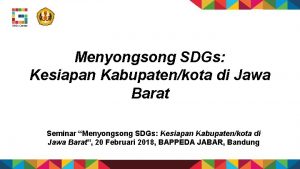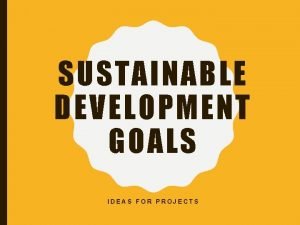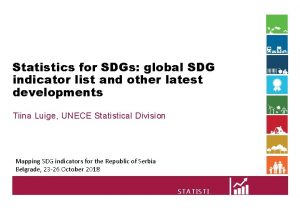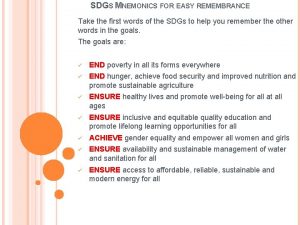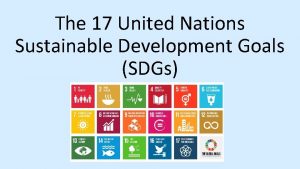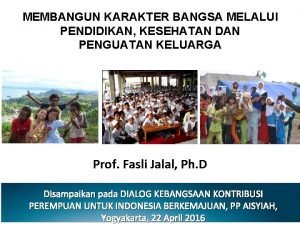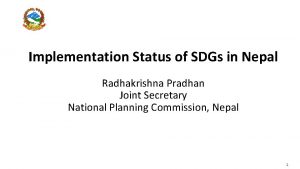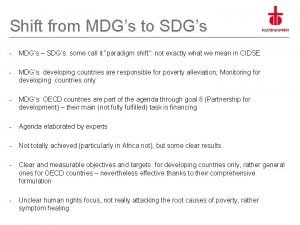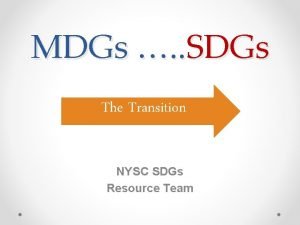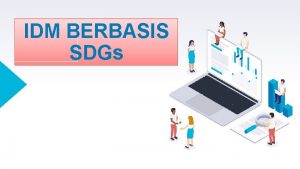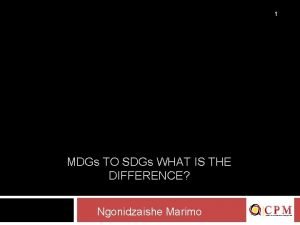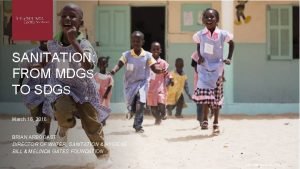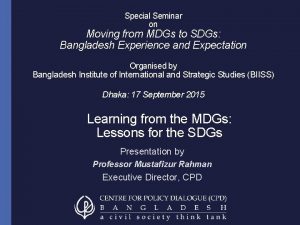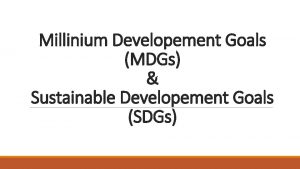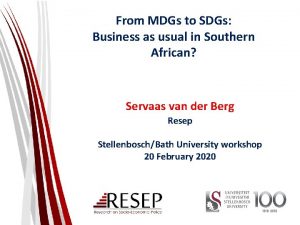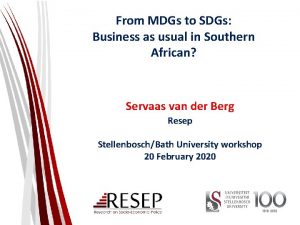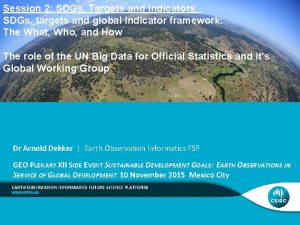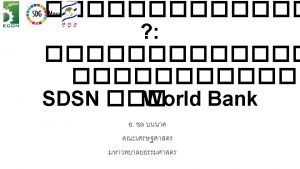From MDGs to SDGs Power and SDGs A



















- Slides: 19

From MDGs to SDGs & Power and SDGs: A feminist analysis Presented by Madiha Rauf Hashmi Department of Gender Studies University of Punjab

Presentation Outline Introduction of MDGs From MDGs to SDGs Sustainable Development Goals 2016 -2030 Key features of the SDGs Critique on SDGs Conclusion

MDGs In the United Nations Millennium Summit in 2000, 147 countries adopted MDGs, Which are a set of numerical and time-bound targets to measure achievements in human and social development by the end of 2015. Goals Eradicate extreme poverty and hunger Achieve universal primary education Promote gender equality and empower women Ensure environmental sustainability Reduce child mortality Improve maternal health Prevent the spread of HIV/ AIDS, malaria and other diseases Develop a global partnership for development

Criticism Perceived by many developing countries primarily as a “top-down” initiative It was developed by a small group of experts and was not member state driven It is too aid focused/donor driven, mostly targeting developing countries Narrow concept of development (meeting basic needs, poverty alleviation) It overlooked the issue of inequality (specific population groups) Not aligned with human rights principles Failed to connect other UN- led development conferences Inappropriate for countries at different levels of development(with targets that were under-ambitious or irrelevant to current challenges, such as universal primary education in countries where it had been largely achieved) Little or no consideration given to their implications or feasibility at the regional or country level

Cont. . The targets under Goal 8 are not numerical and do not set any specific deadlines For overly technocratic implementation, based on an assumption that resources and technology are the answer to poverty Simplistic vision of meeting basic needs for all without recognizing the root causes of poverty embedded in power relations and exacerbated by current economic models of neoliberal globalization that priorities corporate profit over human rights MDGs had numerous effects on shaping development discourse that favoured target-driven strategies, and in most cases undermined human rights and capabilities approaches that emphasized empowerment of people and addressing the root causes of poverty and unequal development Silent on the need to reform institutions

Feminist Critique MDGs served to undermine local agendas and political dynamics Misdirected, and did not challenge the neoliberal economic model that was intensifying inequalities, and ignored the key issues of systemic reforms in the global economy. Extraordinarily narrow (For example, the entire 13 -point agenda for action adopted at Beijing was reduced to MDG Goal 3) Most pressing contemporary challenges were left out: inequality, unemployment and stagnant wages, climate change, financial market volatility, migration, the ineffectiveness of global institutions to manage globalization.

Evolution of SDGs from MDGs

MDGs vs SDGs

MDGs SDGs Measurable (numeric goals) they are not tangible and measurable outcomes Brief and simple Too many and Some SDG goals and targets are focused on complex concepts and the quality development processes such as ‘sustainability’ and ‘inclusion’, quantification reduces complex and intangible visions such as development that is inclusive – into concrete measurable objectives such as all children in school. Goals use the power of numbers to communicate a development agenda with a sense of scientific certitude and serious intent with potential for accountability

Aspects of Sustainable Development Goals Adopted by the United Nations member nations to follow and expand on MDGs which expired in 2015 Result of a three year long transparent, participatory process inclusive of all stakeholders and people’s voices. They represent an unprecedented agreement around sustainable development priorities among 193 Member States. They have received worldwide support from civil society, business, parliamentarians and other actors. The decision to launch a process to develop a set of SDGs was made by UN Member States at the United Nations Conference on Sustainable Development (Rio+20), held in Rio de Janeiro in June 2012. Broader agenda of with respect to gender and cover aspects of complex realities of women’s lives Broder scope of development that includes environmental, social, and economic sustainability Incorporation of SDGs into national planning processes, strategies, and policies is decided by each government A core feature of the SDGs has been the means of implementation (goal 17), the mobilization of financial resources as well as capacity–building and the transfer of environmentally sound technologies.

• The goals and targets are “global” in nature taking into account different national realities, capacities and levels of development and respecting national policies and priorities. • The SDGs recognize without addressing human rights and complex humanitarian issues , development can not be achieved. • The SDGs are people-centered and planet-sensitive. They are universal, applying to all countries while recognizing different culture, realities and capabilities. The goals are not independent from each other; they need to be implemented in an integrated manner. • Transformative: Transforming current challenges into opportunities for the 5 P (peace, people, planet, prosperity and partnership) • Structural reforms ( power structure and shift in economic models, goal 10 and 16 ) • The SDGs also incorporate economic dimensions they include a goal for growth that is sustainable and inclusive (Goal 8). • Goal on inequality (Goal 10) addresses disparities within and between countries

Risks for SDGs A risk that the most transformative goals and targets would be neglected in implementation through selectivity, simplification, and national adaptation. Selectivity could lead to neglect of goals and targets that would address power structural issue( Will SDG 10, to reduce inequality within and between countries, or Target 5. a, to ensure legal right of women to land ownership, receive attention) The carefully negotiated language of the 17 -goal agenda, emphasizing intangible qualitative objectives of equitable and sustainable development, this temptation would be to simplify this language, and strip away the important qualifiers Process of national adaptation. This reduces the political pressure on national governments to address the political causes of poverty and inequality The SDGs are a politically negotiated consensus that has no enforcement mechanism built in. The burden falls on civil society groups to leverage the SDGs as course correction by putting pressure on governments and other powerful actors to account for the commitments made

Feminist analysis Sustainable Development’s vision is not always met with strong enough language, clear policies or funding provision Agenda 2030 maintains a traditional take on gross domestic product growth, implicitly conflating economic growth with societal progress (Industrialisation is still seen as the main driver of growth). Goal 8, 12 and 10 and its targets make explicit a strong growth employment nexus. The hope lies in increased productivity, technological change, and resource efficiency

Cont… This traditional take on growth assumes that countries are ultimately responsible for their development, provided their ‘policy space’ is respected and that a ‘diverse private sector, ranging from microenterprises to cooperatives to multinationals’ is just another stakeholder in development. This conceptual approach thus fails to respond to, or challenge, the macro- economic and structural drivers of current patterns of growth including the structural role of unpaid care and domestic work in supporting economic growth. It also fails to put growth within environmental limits. Agenda 2030 emphasis on strong institutions to shape the development process, including stronger institutions at the global level, but does not challenge the ways inequalities in income, wealth, and power are produced and reproduced at national and global levels, nor does it attempt to transform power relations between the North and the South, between the rich and the poor, and between men.

Social relations of power have been at work as Agenda 2030 was formulated and agreed, and will be working as it is implemented. (big countries, inter-government institutions , particularly those dealing with trade and finances), transnational corporations, and even some huge foundations and international non-governemnt organizations with budgets of billions of dollars contributing to emphasize certain aspects and marginalize others (Addis Ababa Action Agenda maintaining sustainable debt levels is the responsibility of borrowing countries) Rhetoric of accountability, stakeholder participation, social dialogue, and global governance is problematic( case of the public–private sector ‘partnerships for development’, which are encouraged have no provisions which would ensure these partnerships will be transparent and accountable It relates to countries’ accountability, by the ‘high-level political forum under the auspices of the General Assembly and the Economic and Social Council [which] will have the central role in overseeing follow-up and review at the global level’

Based on voluntary country-level reviews, without any universal mechanism to assess each country’s contribution to the global realisation of these goals. Agenda acknowledges national development efforts need to be supported by an enabling international economic environment, including coherent and mutually supporting world trade, monetary and financial systems but it does not indicate how this is going to happen, beyond referring in vague terms to these institutions providing ‘policy coordination and coherence’ to enhance global macro-economic stability(lack of coordination and coherence) Agenda seems to be a reliance on ‘voice and participation of developing countries … in international economic decision-making, norm-setting and global economic governance’ referring to international economic and financial institutions), although it is not clear through which mechanisms this is to happen and change the power structure(percentage of members or voting rights of developing countries in international organizations’, actually tell us, when these international organizations just do not exist?

Although genuine empowerment always involves changing unequal power relations, donors and investors tend to favour an apolitical use of the term, in which power relations may actually remain wholly or virtually untouched Women’s full and effective participation and leadership is not only dependent on women’s own effort and interest in coming to the national and international negotiating tables and having equal opportunities to men to participate –but also on access to the resources that act as preconditions for participation (money, time, confidence, and education among them), and on the existence of concrete mechanisms for promoting women’s participation (could provide a platform from which to work on such mechanisms, though it is too vague )

Whether or not growth contributes to gender equality depends on growth patterns. That is to say, it matters which sectors drive economic growth, and whether they are able to generate decent employment for women. It also matters what role the state takes in redistributing the gains from growth; and the various patriarchal structures that curtail women’s ability to take advantage of the gains of growth

Conclusion Human rights framework, strong in the Agenda introductory paragraphs but weak in the goals, targets, and accountability mechanisms. The implementation phase will open new struggles for interpretation over the scope of concepts, responsibilities, policies and achievements, and new terrains for contestation. To overcome and transcend this, and make the SDGs work for women, it will be necessary to bridge the fissures between and among advocates of economic justice and gender justice, forging stronger and broader alliances and common agendas, including for defending the gains enshrined in Goal 5, in particular at the national level These include addressing the growing inequalities within and between states (see goal 10) and specifically between men and women (see goal 5); addressing accountability mechanisms and financing (see goal 17 and targets 10. 4, 10. b, 10. c); and recognising the burden of women’s unpaid labour, in the form of reproductive and care work (see target 5. 4)
 Sdgs jawa barat
Sdgs jawa barat Sdgs project ideas
Sdgs project ideas Sdgs list
Sdgs list Mnemonic for sustainable development goals
Mnemonic for sustainable development goals Https://sustainabledevelopment.un.org/sdgs
Https://sustainabledevelopment.un.org/sdgs Pilar lingkungan sdgs
Pilar lingkungan sdgs Sdgs 2030
Sdgs 2030 Elina bardram cv
Elina bardram cv Sdgs
Sdgs Sdgs
Sdgs Ac power formula
Ac power formula Solar power satellites and microwave power transmission
Solar power satellites and microwave power transmission Potential power
Potential power What is dispersive power of grating
What is dispersive power of grating Flex28024a
Flex28024a Power of a power property
Power of a power property General power rule
General power rule Power angle curve in power system stability
Power angle curve in power system stability Power bi training powerpoint
Power bi training powerpoint Power absorbed or supplied
Power absorbed or supplied
